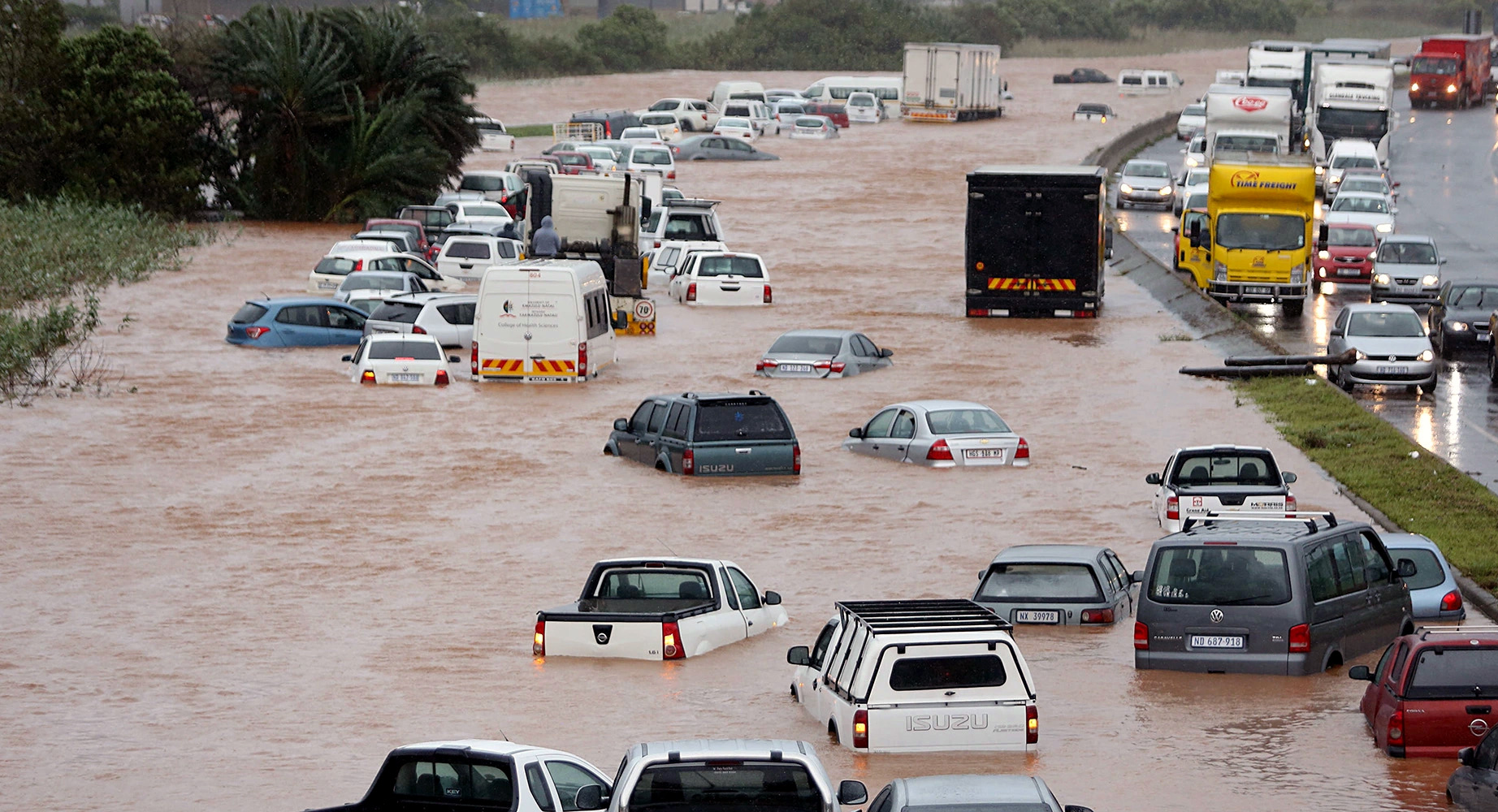Severe floods have plagued Durban since 2022. In April of that year, flooding killed more than 450 people and displaced more than 40,000. In 2023, floods and recurrent storms damaged critical infrastructure, killed more than 22 individuals, and displaced thousands more.
The 2024 floods, driven by El Niño, claimed more than 45 lives and disrupted efforts to rebuild flood-damaged infrastructure from previous years. In early 2025, persistent heavy rains worsened erosion and the housing crisis, further exposing the city’s poor urban planning and vulnerability to climate change.
To put things into perspective, over the past three years, Durban has faced devastating floods and extreme weather events that have killed more than 530 people and displaced over 45,000. Many of the displaced still live in crowded temporary shelters.
Flooding alone has exacerbated existing socio-economic challenges, displaced entire communities, and strained public safety and social cohesion — costing the city over R120-billion.
More than just a climate disaster, recurring floods have exposed the compounding crisis of climate shocks, infrastructure neglect and socio-economic inequality in Durban.
It is unsurprising that every year, flooding in Durban dominates headlines. What has also become predictable is the government’s response: days after each flood, the South African government declares Durban – and to some extent KwaZulu-Natal – a state of national disaster.
This declaration enables both national and provincial authorities to mobilise resources swiftly to mitigate the floods’ impact and provide relief to affected communities.
Meanwhile, politicians and public representatives use these disasters to coordinate high-profile responses – helping bury the dead, accommodating and feeding the homeless, searching for the missing, assessing losses and repairing public infrastructure.
/file/dailymaverick/wp-content/uploads/2025/07/ED_395356.jpg)
Dangerous blind spot
But Durban’s recurring floods are doing more than destroying homes and infrastructure – they are exposing SA’s dangerous blind spot at the intersection of climate disasters, human displacement and social disintegration.
At the heart of this crisis is a recurring, disjointed and uncoordinated approach to flooding among three critical spheres: government, humanitarian organisations and academic institutions.
The pace, focus, and operating methods of these spheres have led to fragmented disaster responses, undermining the country’s capacity to effectively mitigate such events, particularly for ordinary people.
As climate shocks intensify each year, a troubling pattern emerges: research institutions produce volumes of data on climate migration, and policymakers draft short-term emergency plans – yet their efforts remain stubbornly disconnected.
For example, researchers warned of climate-induced displacement in Durban as early as 2022, and policymakers had disaster management plans in place. Yet, when thousands were displaced, their relocation triggered violent clashes in areas like Phoenix and Verulam.
Why? Because research on migration patterns never reached local officials, and emergency policies failed to account for the simmering social tensions in host communities.
This policy-research disconnect reveals four critical gaps:
1. Temporal mismatch
Academic studies often arrive after policy windows have closed. For example, a 12-month lag in publishing data on flood-related migration rendered research too late to influence urgent decisions. Policymakers, driven by immediate political and resource concerns, have routinely overlooked peer-reviewed findings that could inform better planning.
2. Structural divide
Researchers tend to focus on climate vulnerability, while policymakers concentrate on disaster response – yet neither engages adequately with the migration-conflict nexus. During the 2022 Durban floods, for instance, officials made quick decisions about shelter allocation without real-time data on migrant exclusion patterns, overlooking the very social fractures that would later lead to violence.
Climate crises demand embedded research that aligns with decision-making cycles – not just academic timelines.
3. Geographic blind spot
National policies often ignore Durban’s unique risk profile – a volatile mix of coastal climate exposure, dense urban settlements and historical ethnic tensions.
A 2023 University of KwaZulu-Natal study found that 72% of climate migrants experienced hostility in host communities. Yet provincial disaster plans lacked conflict-sensitive relocation strategies. Researchers, too, frequently miss local nuances, such as how resource scarcity in Durban’s informal settlements fuels scapegoating of displaced populations.
4. Incentive misalignment
The repeated use of the same policy responses in 2023, 2024, and 2025 highlights a misalignment of priorities. During each flood, while victims scramble for safety and shelter, researchers race to gather data for high-impact journal publications. In contrast, local officials urgently need simple, accessible risk maps to guide immediate decision-making.
The consequences of this disconnect are tangible. A 2023 African Climate Foundation study found that 78% of climate-displaced persons in Durban faced hostility from host communities, while disaster plans had no provisions for conflict mitigation. Academics studied displacement in isolation, while SAPS and informal settlement leaders held untapped, practical knowledge about which relocation sites were most likely to spark unrest.
/file/dailymaverick/wp-content/uploads/2022/11/MC-KZN-Flood-Victim.jpg)
After the 2024 floods, displaced communities in Durban improvised makeshift drainage systems that outperformed some official interventions. Yet, these grassroots innovations remain absent from formal government reports. When documented by academics, they revealed blueprints for climate resilience that continue to be ignored by formal plans.
This is the cost of working in parallel, rather than in partnership. Policymakers need real-time, hyper-local data: which wards are most flood-prone? Which leaders can mediate tensions?
Researchers must go beyond theoretical models and embed themselves in the realities of municipal governance. Without this synergy, the next climate disaster in Durban will not only displace thousands – it will destabilise communities.
While yearly floods have already exposed Durban’s fragility, it is the failure to connect policy and research that threatens the city’s future. The bridge between the two must be built – and soon. DM
Dr Joseph Makanda is a Climate Security Research Specialist at the Alliance-Bioversity International-CIAT in Pretoria.




 Cars semi-submerged on the road during severe floods in Durban during October 2017. (Photo: Gallo Images / The Times / Thuli Dlamini)
Cars semi-submerged on the road during severe floods in Durban during October 2017. (Photo: Gallo Images / The Times / Thuli Dlamini)